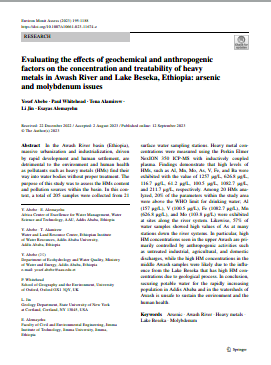Yosef Abebe, Paul Whitehead, Tena Alamirew, Li Jin and Esayas Alemayehu
In the Awash River basin (Ethiopia), massive urbanization and industrialization, driven by rapid development and human settlement, are detrimental to the environment and human health as pollutants such as heavy metals (HMs) find their way into water bodies without proper treatment. The purpose of this study was to assess the HMs content and pollution sources within the basin. In this context, a total of 205 samples were collected from 21 surface water sampling stations. Heavy metal concentrations were measured using the Perkin Elmer NexION 350 ICP-MS with inductively coupled plasma. Findings demonstrate that high levels of HMs, such as Al, Mn, Mo, As, V, Fe, and Ba were exhibited with the value of 1257 μg/L, 626.8 μg/L, 116.7 μg/L, 61.2 μg/L, 100.5 μg/L, 1082.7 μg/L, and 211.7 μg/L, respectively. Among 20 HMs analyzed, 20% of the parameters within the study area were above the WHO limit for drinking water; Al (157 μg/L), V (100.5 μg/L), Fe (1082.7 μg/L), Mn (626.8 μg/L), and Mo (103.8 μg/L) were exhibited at sites along the river system. Likewise, 57% of water samples showed high values of As at many stations down the river systems. In particular, high HM concentrations seen in the upper Awash are primarily controlled by anthropogenic activities such as untreated industrial, agricultural, and domestic discharges, while the high HM concentrations in the middle Awash samples were likely due to the influence from the Lake Beseka that has high HM concentrations due to geological process. In conclusion, securing potable water for the rapidly increasing population in Addis Ababa and in the watersheds of Awash is unsafe to sustain the environment and the human health.

